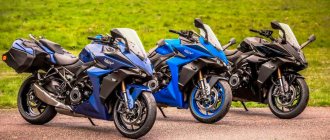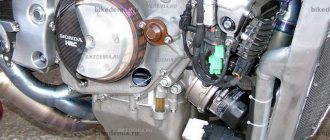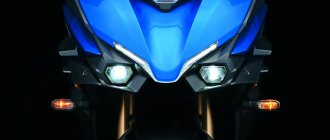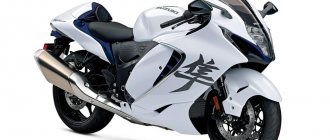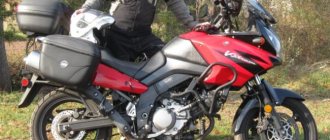The 2022 Suzuki GSX-S1000GT sports-touring motorcycle can hardly be called a new motorcycle: the vast majority of its components are already known from previous versions and related models. First of all, this concerns the engine: the inline-four, based on the GSX-R1000 K5 engine, dates back to 2005, and the frame, swingarm, wheels, suspension and brakes taken from the GSX-S1000 road bike suggest that the GT will be a very recognizable motorcycle.
Suzuki GSX-S1000GT 2022
However, sitting in a soft saddle and looking forward and slightly down, you don’t think too much about the fact that there are old components under you. Perhaps a modern dashboard with a 6.5-inch TFT screen that displays a lot of useful information in a modern style and supports wireless communication with a smartphone, further increasing the level of convenience, distracts you from sad thoughts.
Slightly lowered footpegs, which provide a more relaxed fit, and a handlebar with rubberized spacers give comfort and smooth out vibrations - you can feel the care for the rider and the experience in developing long-range motorcycles. And given the size of the stylish fairing with a fairly high windshield, wind protection is also up to par.
A couple of minutes to set up, a couple more to get used to the landing - and off you go! The 150-horsepower “old man” engine works perfectly and deserves all praise. It's not at all hampered by the fact that it's sort of like a 16-year-old: the traction, elasticity, superb manners, smoothness and power are legendary by today's standards.
The first stage of the test ride is devoted to getting used to the motorcycle - a simple, free road runs through a charming area, allowing you to get used to the controls and admire the scenery. But given that the GT doesn't require any special getting used to and the road just keeps moving forward, it soon becomes a little boring. And it’s not that the GT somehow encourages you to push it to the footpegs, on the contrary, it behaves quite adequately during a quiet ride, without twitching or showing displeasure from the vegetable pace, even in the most vigorous of the three driving modes - A.
Suzuki GSX-S1000GT 2022
Fortunately, the possibility of more dynamic driving soon appears. True, it starts to rain right away, but it’s not scary: a touring motorcycle must be prepared for this, and riding on wet asphalt itself conceals only one little secret: “don’t be a maniac and don’t go where your head can’t fit.” So the opportunity to ride in the rain is just one element of the test, allowing you to experience the behavior of the Suzuki GSX-S1000GT in real conditions and find out whether it is friend or foe in general.
The friendly nature of the new sports tourer is quite obvious, and although its set of on-board electronics is no longer quite up to par with modern ideas (mainly due to the lack of an inertia measuring device), traction control and ABS allow you to stay not only in order, but also in good spirits. mood. Both systems do not simply intervene out of the blue - therefore, they allow you to find the line beyond which it is no longer safe and stick to it.
In general, despite the increased amount of precipitation on the first day of the test, it went great. The motorcycle proved to be comfortable, practical, easy to control, cheerful, with a good character, and so on. True, the rain did not allow us to take good photos, but that’s not the main thing in testing, is it? Or the main thing?
In general, the group of testers did not mind riding slowly in the rain at all, but they seriously hoped that the weather would improve on the second day. So the cool but completely clear sunrise of the second day was greeted with enthusiasm by everyone.
Hands freezing in gloves still damp after yesterday's rain make you dream of heated grips (alas, optional). Fortunately, warm, almost winter gloves were hidden in one of the trunks! The panniers themselves are, perhaps, a little wide for vigorous driving in the aisles, but they are comfortable and quite voluminous - 36 liters each, and most importantly in these conditions - they are waterproof! Unfortunately, they are also offered as an option: for some reason Suzuki decided that the Grand Tour model is not a reason to install stock panniers.
Suzuki GSX-S1000GT panniers
MotoGP: Suzuki GSX-RR (2021) with comments from technical director Ken Kawayuchi
Probably for the first time in the last decade, the new generation MotoGP prototype differs so little from the previous one! The factory 2022 Suzuki GSX-RR is so similar to the 2020 championship bike that it's hard to notice the slightest changes. Ken Kawayuchi, technical director of Team Suzuki Ecstar and lead developer of the GSX-RR project, spoke about what has changed.
MOTOGONKI.RU, March 6, 2022 — The secret to the success of the 2022 generation Suzuki GSX-RR is that it has everything in moderation. Since 2013, Honda, Ducati and Yamaha have been doing nothing but trying to outdo each other in the “motor race”. First, they were faced with a task - even more power! Then, the power became too much, and they went in the opposite direction - how to curb this power? Honda and Ducati were able to smoothly switch to new unified control electronics in 2016 and new unified tires from Michelin, while Yamaha remained in a limbo situation for several years, which they tried to resolve until 2022, and even today there is no clear answer - solved the problem or not.
Suzuki did things differently from the very beginning. Traditionally, the plant used a V4 in its 4-stroke prototypes, which was different from all the developments that the Japanese company had. During the heyday of 2-stroke technology, Suzuki and the RGV500 were truly at their peak. The 2000 season was the last one to become truly successful before the transition from GP500 to MotoGP. But the next year, 2001, turned out generally well for Suzuki - 3rd place in the Manufacturers' Cup. Hamamatsu decided this: if we can make such successful 2-stroke V4s, then we’ll probably make a 4-stroke one too. But here the Japanese engineers miscalculated. It’s hard to say why exactly, but from 2002 to 2011 the plant no longer competed for the title, regularly finishing at the bottom of the Manufacturers’ Cup rankings. This led to the decision to temporarily close the project in MotoGP and withdraw from the championship. But the promise to return came on the same day that Rizla Suzuki MotoGP manager Paul Denning announced Hamamatsu's decision at a press conference at Le Mans.
Evolution of Suzuki GSX-RR from 2015 to 2022
What has been done over the years? The Suzuki project did not stand idle! All this time, the factory was puzzling over the question: how to win the engine race by making the V4 more powerful, more reliable and more obedient?
The decision came unexpectedly: why did we end up with this very “V4”?!
At the end of 2013, Ken Kawayuchi proposed a revolutionary idea - to abandon the GSV-R prototype in favor of developing a fundamentally different, in-line 4-cylinder engine and chassis for it. The motorcycle was ready in less than a year and appeared at the 2014 Valencia Grand Prix with Sylvain Guintoli in the saddle. And although Sylvain did not reach the finish line, a start had been made - and a good start!
Technical Director of Team Suzuki Ecstar Ken Kawayuchi
“We built on our experience with the GSX-R1000, which for many years represented the optimal balance of power and speed in the Superbike class. Suzuki has produced and sold a million Jixers*, and a million owners can't be wrong! - recalls Ken Kawayuchi. “That’s why the development went so quickly and so successfully: we simply used the experience proven by three decades of development and evolution.”
* Suzuki reached one million GSX-Rs produced since 1984 at the end of 2011. In 2012, a commemorative version of the Suzuki GSX-R1000 “1million Production Anniversary Edition” was released.
Team Suzuki Ecstar found itself in something of a privileged position when it returned to MotoGP. Their entry into the championship coincided with a global technical revolution, the transition to unified Magneti Marelli control units and unified control software from Dorna Sports, but also to fundamentally different tires from the French manufacturer Michelin. When competitors were forced to rebuild for three years in a row, Suzuki started work literally from scratch, adopting all new technologies at once!
MotoGP 2022 – Team Suzuki Ecstar & Suzuki GSX-RR go to photo gallery
“Our way of understanding the motorcycle was through understanding Michelin,” continues Kawayuchi. “This helped avoid many dead ends.” We just made sure the bike's handling and power delivery matched the tires exactly. And by 2022, we have achieved a more or less stable balance in the overall package. Our goal after 2020 is simple: maintain this balance, and not make the bike more powerful and nervous.”
MotoGP 2022 – Team Suzuki Ecstar & Suzuki GSX-RR go to photo gallery
There is practically no development of the model in 2022 - just minor improvements, details that do not affect the overall performance. No new engine, no frame, no aerodynamics. In addition to the principle “if it works, don’t touch it,” there is also a purely pragmatic approach: everything comes down to finances and new big plans.
MotoGP 2022 – Team Suzuki Ecstar & Suzuki GSX-RR go to photo gallery
“Due to the Covid-19 situation, we have postponed all developments, the new bike will only be available in 2022. We really hope that we will soon sign a contract with a new partner and launch a satellite team to enter the new season with four motorcycles. This is our goal. At the same time, this is a significant burden on the budget, so we are at the stage of assessing the situation. Perhaps solving this problem will take more effort and resources than we expected. In this case, postponing the GSX-RR development program by six months is a good decision,” concluded Kawayuchi.
MotoGP 2022 – Team Suzuki Ecstar & Suzuki GSX-RR go to photo gallery
But this does not mean that the plant did nothing for 5 months. Suppliers of key components worked hard! The prototype has completely new parts, no different in appearance, but they are 2022 specification - Brembo brakes, a new Ohlins carbon fork, a modified air intake for brake cooling - a little bit of everything.
MotoGP 2022 – Team Suzuki Ecstar & Suzuki GSX-RR go to photo gallery
Suzuki GSX-RR (2021) Specification:
Engine:
liquid cooled, 4-cylinder, in-line, DOHC 16 valves.
Displacement:
1000 cc.
Max power:
over 240 hp
Max speed:
over 340 km/h
Exhaust system:
Akrapovic, titanium, prototype
Ignition system:
electronic
Electronics:
Spec ECU and IMU Magneti Marelli AGO 340, GPS
Control software:
Dorna Sports
Feedback system:
2D VPB (Virtual Pit Board)
Transmission :
Seamless, manual transmission 6-gears
Drive:
DID 525
chain Chassis:
Frame - diagonal, aluminum Fork - Ohlins 48 mm Aluminum swingarm with lower shock absorber mount Shock absorber - Ohlins TRSP44
Wheels/tires:
17″ magnesium alloy
Tires:
Michelin PowerSlick 17″ with TAPS pressure sensors
Brakes:
front - Brembo radial 4-piston.
GP4-RR calipers, 320 or 340 mm carbon wheels; rear - Brembo, Yutaca steel wheel 252 mm Fuel tank:
aluminum, 22 l
Dimensions (L x W x H):
2096 x 720 x 1140 mm
Wheelbase:
1457 mm (+/- 30 mm)
Weight:
157 kg
More detailed photos of Suzuki GSX-RR:
MotoGP 2022 – Team Suzuki Ecstar & Suzuki GSX-RR go to photo gallery
The new sponsor of the factory team Team Suzuki Ecstar is energy drink manufacturer Monster Energy. The contract was concluded for many years at once. Monster will appear both on the motorcycle and on the overalls of Alex Rins and Joan Mira. But the Monster colors do not yet affect the harmonious original Suzuki Racing scheme - blue-white-silver.
MotoGP 2022 – Team Suzuki Ecstar & Suzuki GSX-RR go to photo gallery
Aerodynamic kit for 2022 model year. It was updated after the San Marino Grand Prix, minimally.
MotoGP 2022 – Team Suzuki Ecstar & Suzuki GSX-RR go to photo gallery
New design of the rear of the motorcycle - new plastic, shape and Monster logo.
MotoGP 2022 – Team Suzuki Ecstar & Suzuki GSX-RR go to photo gallery
The frame and engine are generally unchanged: the next evolution is only in 2022. Until then, the plant does not plan to invest too much in development.
MotoGP 2022 – Team Suzuki Ecstar & Suzuki GSX-RR go to photo gallery
No carbon: the frame and swingarm are traditionally purely aluminum, without reinforcing inserts or reinforcement.
MotoGP 2022 – Team Suzuki Ecstar & Suzuki GSX-RR go to photo gallery
A distinctive feature of the 2022 model is the “shovel” that has taken its place in the aerodynamic kit under the rear wheel pendulum. This simple device has a dual purpose: officially, it is a device for cutting off dust and water flying from under the front wheel; unofficially, a device that greatly increases the downforce on the rear wheel.
MotoGP 2022 – Team Suzuki Ecstar & Suzuki GSX-RR go to photo gallery
Joan Mir will continue to wear number “36”: the choice was made in January. Mir believes that this lucky number has already brought him two world titles and will help him defend it in 2022. And if this happens, you can change it to “1”.
If you missed the presentation, watch the replay on MOTOGONKI.RU
The first shortcomings in the Suzuki GSX-S1000GT
A cool morning revealed the first shortcomings in the Suzuki GSX-S1000GT - tires and brakes. The test bikes were shod with the same rubber as the GSX-S road bike, and it's grippy enough to handle a summer track, but not grippy enough for cold riding. It’s not that it’s completely useless, but the rear periodically squirms during acceleration, fortunately the traction control does not allow it to perform very fierce somersaults.
Fortunately, the market is full of excellent touring tires, and this issue can be resolved in no time. And it’s exactly the same story with the brake pads: they brake quite well and are quite informative - provided that they are warmed up or it’s warm outside. Cooled by cold wind and rain, the pads have almost no pronounced initial bite, that is, the brake operates quite sharply and with a fairly conscious force on the lever.
Nice day on the Suzuki GSX-S1000GT
The cool morning slowly turned into a pleasant warm day, and the testers thawed out along with nature, increasing the pace and degree of fun.
The Suzuki continued to be worthy of all praise: on dry roads both the tires and brakes worked as they should, and the luxurious engine adorned it all. The airbox and exhaust have a funny GSX-R-esque sound when you open it wide, although you don't necessarily need to open that wide to go fast.
The chic standard bi-directional quickshifter, clear gearbox and soft clutch release encourage you to once again work with your left foot (and hand if you’re in the mood). The number 6 on the dashboard is often surprising - somehow you don’t feel from the excellent acceleration out of corners that you are driving at the bottom in top gear.
On dry roads, the steering precision of the Suzuki GSX-S1000GT, the stability and at the same time the ease with which it changes direction, are very pleasing: just a little effort on the wide handlebar is enough to direct the motorcycle where you need it. The updated suspensions not only provide precise steering, but also perfectly handle road unevenness, even during acceleration, braking and incline. The fork has a full set of adjustments, and the rear shock absorber is adjustable for spring preload and rebound, while the stock settings are quite enough for responsive steering and a comfortable ride.
Time flew by, and it was time to hand over the motorcycles. It would be great to ride somewhere further away and see how the Suzuki GSX-S1000GT handles on a long road trip. Most likely, it will be very good, especially if you believe in Suzuki's claimed range of 300+ kilometers. After all, as was said earlier, the only clear review of a touring motorcycle is a long-range one
In general, their motorcycle turned out to be extremely successful, and most likely it will be successful in the market. For Suzuki, real sports tourists are a rarity, but this time they are just great. The GT does everything as a good sports tour should, and for dessert it leaves very serious performance in which the GSX-R genes are clearly visible.
Metamorphoses
Suzuki followed this path, with the only difference that the base for the new city naked GSX-S1000F was chosen not from the current, but from the previous generation of the sportbike. This is understandable, because the world premiere of the “road bike” took place a year earlier than the new flagship sports motorcycle GSX-R1000.
Compared to Odnoklassniki, which is based on new platforms, this decision may seem strange. But, apparently, Suzuki rightly judged that the previous platform had already been tested and verified, and the “childhood diseases” had long been cured. So the motorcycle, which debuted last year on the world market, and this season on the Russian market, will fall into the hands of experienced mechanics who know its design by heart, and dealers who already have many components and, importantly, are ready to offer a wide selection of tuning, including including from third-party manufacturers.
A win-win! In addition, the device debuted in two versions at once - “undressed” (not to be confused with “naked” - the equipment is quite decent) and hooded, characterized by slightly more developed wind protection and an extraordinary design. It was this that we decided to test in action by traveling through the streets of Moscow.
In the saddle, the car doesn’t betray its sporting roots - its bright appearance and complex headlight with “blooming” dimensions and “turn signals” like flower leaves are captivating, but otherwise everything is restrained in the Japanese way. The quality of fitting of parts is excellent, the ergonomics are adjusted to the point of indecentness, every key is in its place, the saddle is captivatingly soft, and the steering wheel is spacious.
The downside of such practicality is the absence of revelations and bold decisions, which is especially emphasized by the digital monochrome dashboard: informative, understandable, familiar. A motorcycle for nerds? Well, no, the 150-horsepower engine with a sporty character will definitely not let you get bored, no matter how restrained the decoration of the driver’s seat may try to mislead.
Touch the starter button and the engine starts on its own: the electronics of the new product turns the starter as much as necessary to start, and it is not necessary to press the button all this time. However, the starter doesn’t have to work for long – half a turn, and everything around is filled with the rumbling of the engine. But the assistant, which adds speed when starting from a traffic light, on the contrary, is extremely useful; stalling when starting is now more difficult, although it is possible if you really openly drop the clutch.
The gearbox works perfectly smoothly, the gears are switched according to the standard, but the engine settings remain sporty - the main torque starts at 6-7 thousand revolutions, and before the tachometer needle approaches this value, the acceleration dynamics are not amazing. But then, to the roar of a Formula 1 car, the motorcycle literally shoots forward, trying to tear the front wheel off the asphalt.
However, lifting the front end during acceleration is not dangerous, because three-level traction control closely monitors it: in the first mode, it allows the front end to rise or (if the adhesion of the rubber to the asphalt is far from ideal) the rear wheel to slip a little. The second, transitional mode makes the electronics a little stricter, increasing its interference, and the third, the so-called rain mode, generally softens the engine’s reactions to turns of the gas handle, while the stabilization system cuts off all attempts of the motorcycle to get out of control in the bud. .
In addition, this function can be disabled. But why, because you can misbehave even in the most dynamic mode, where the supervision of electronics is invisible. In any case, the new Suzuki GSX-S1000F goes either very fast if you rev the engine, or very quietly when the tachometer needle does not rise above 6 thousand rpm. Compromises are not for him. At least in the engine. The chassis, on the contrary, contributes to a comfortable ride; the torsional rigidity of the frame and the density of the fully adjustable suspensions are sufficient for both high-speed shooting and measured driving, and the device feels good in traffic jams.
The Brembo brakes are also good - with only one correction: the standard brake hoses swell too much, which is why the feedback leaves much to be desired. I would immediately replace them with reinforced ones. Or I left it as is and pressed harder on the levers, because there is no danger of pressing the brake and blocking the wheel - the ABS system will protect you in case of an error and provide confident braking from any speed.
Features of Suzuki GSX-S1000GT
The new Suzuki GSX-S1000GT is powered by a powerful 999cc liquid-cooled twin-overhead inline-four, which has undergone a number of upgrades and modifications to increase power and achieve the perfect balance of performance and Euro 5 environmental friendliness. Suzuki says the new version delivers superbike-level efficiency, reduced vibration, comfort and reduction of fatigue both over long distances and during everyday city driving. Its wide, smooth thrust curve ensures excellent engine performance at any speed - excellent response and acceleration, the ability to shift less during quiet driving and the convenience of riding with a passenger and luggage.
All this is complemented by a slipper clutch that provides smooth operation when shifting down and has a light squeeze function - despite the soft movement of the clutch lever, when it is fully released, the clutch strengthens the engagement between the discs, which allows the use of soft springs without the risk of slipping. As a result, it is convenient to modulate traction using the clutch lever without tiring the left hand, which is very useful when driving in heavy traffic, for example.
Suzuki GSX-S1000GT
Suzuki engineers achieved light and nimble steering thanks to well-selected and well-designed chassis components, which allow them to combine dynamic driving with the straight-line stability required on long journeys. The compact and lightweight chassis with twin-spar aluminum frame and durable aluminum swingarm provide excellent road holding even when riding with a passenger and a full load of luggage. The new subframe provides a stronger and more secure fit for the side panniers, and also makes the passenger part of the seat thicker and softer. Fully adjustable 43mm KYB inverted forks and linkage rear suspension contribute to both the sport and touring credentials of the bike. Six-spoke alloy wheels shod in road rubber are designed specifically for the GSX-S1000GT and are equipped with a set of brake discs with Brembo calipers. Monoblock calipers feature four 32mm pistons and are mounted on 310mm floating discs, delivering powerful stopping power, excellent cooling and precise modulation, while ABS is compact and lightweight, allowing the rider to maintain full control even during emergency braking. The system, which monitors wheel speed, adjusts the braking force in a circuit that slows the wheel so much that it loses traction.
The designers showed special concern for the comfort of the driver and passenger, not only isolating the steering wheel from engine and road vibrations with anti-vibration inserts, but also developing the seats thick and soft enough for the comfort of long trips, and the covering material has anti-slip properties. New passenger grab handles behind the rear seat provide a comfortable ride for two, and even the aluminum pegs are coated with an anti-vibration rubber compound.
In search of the optimal riding position for long-distance touring, engineers positioned the handlebars 14mm closer to the rider than on the previous Suzuki GSX-S1000F. This allows him to sit more upright, which again improves travel comfort. The new variable-section handlebars have been made 23mm wider, which not only provides a more comfortable fit, but also allows you to control the motorcycle with less effort.
The Suzuki GSX-S1000GT is the first production motorcycle from Suzuki to feature a full-color TFT screen on the instrument panel. The 6.5-inch multi-function screen has been designed specifically for use in motorcycle instrument panels, with anti-glare coating and improved viewing angles and durability. A wirelessly connected smartphone allows you to use a number of additional functions: the Suzuki mySPIN application broadcasts the image displayed on the smartphone display to the motorcycle dashboard, allowing you to use your smartphone without taking your hands off the wheel, including managing calls, calendar, music and navigation application. In addition, this application allows you to run in this mode a number of third-party programs that are optimized for working in conjunction with a motorcycle and provide convenient functionality while riding - navigation, tips, music streaming, location tracking and transfer, route transfer and weather forecast. Suzuki mySPIN is available for iOS and Android, and the smartphone can be connected not only via Bluetooth, but also via Wireless LAN (Wifi) or even a USB cable with the possibility of simultaneous charging.
Suzuki GSX-S1000 heavily updated
The Japanese manufacturer presented a seriously redesigned liter naked bike. Engine power was increased, handling was improved, and the motorcycle received a new look.
The GSX-S1000 has been produced since 2015 and has found a warm response from buyers, not least because of the derated in-line four from the Suzuki GSX-R installed on it. It was decided to continue production of the popular streetfighter in 2022 and make it even better.
The appearance of the motorcycle can safely be called aggressive, and the brutal name of the design concept “Razor Sharp and Ready to Strike” corresponds to this. The main visual element when looking “eye to eye” was the vertically placed LED headlight - however, all other optics are also LED. The minimalist cladding surrounding the headlight is reminiscent of both the geometry of Suzuki's MotoGP racing cars and the lines of stealth aircraft.
The bike's tail and compact 4-2-1 exhaust system complement the sleek appearance of the new product, focusing attention on the meaty combination of engine, gas tank and everything located between and next to them. As a result, even standing still, the GSX-S1000 looks dynamic.
The heart of the motorcycle is an updated 150-horsepower (+ 2.5 hp) 999 cc in-line four-cylinder Euro 5 liquid-cooled engine with smooth power and thrust curves throughout the entire rev range. Improvements have been made to the camshafts, valve springs, fuel injection system and air filter housing. The new model now also has the Suzuki Clutch Assist System (SCAS) for smooth, controlled deceleration when downshifting.
The 2022 GSX-S1000 receives the Suzuki Intelligent Ride System (SIRS), which combines five-mode switchable traction control, ABS, three-mode electronic throttle, quickshifter, easy starting system (without using the clutch lever in neutral) and low-speed assist. SIRS optimizes the motorcycle's performance based on riding conditions, road surface type, and the rider's riding style and experience.
The chassis includes a rigid, bias-ply aluminum frame and aluminum swingarm, identical to those found on the GSX-R1000, plus adjustable KYB suspension. What are other news? These include an 810mm saddle shape, six-spoke wheels shod with Dunlop Roadsport 2 tyres, a larger, narrower fuel tank to 19 liters, a new handlebar shape (23mm wider, 20mm closer to the driver), a color LED instrument panel and radials. four-piston Brembo calipers operating on 310mm floating brake discs. The dry weight of the motorcycle is 214 kilograms.
Color options for the 2022 GSX-R1000 include Metallic Triton Blue, Metallic Matte Mechanical Gray and Glass Sparkle Black. Sales of the new motorcycle will begin in the fall of this year, prices are being confirmed.
Electronic systems Suzuki GSX-S1000GT
The Suzuki Intelligent Ride System (SIRS) includes a range of advanced electronic systems to optimize motorcycle performance based on riding style, skill and riding conditions, providing a safe and enjoyable ride with excellent predictability and fatigue-free handling.
Suzuki Drive Mode Selector (SDMS) is a driving mode switch that allows you to select one of three modes:
A mode (Active) gives the sharpest throttle response , and the traction settings are perfectly tuned for excellent acceleration. This mode is perfect for dynamic driving - for example, racing on a track or driving along serpentine roads in good weather.
Mode B (Basic) provides the same level of performance as Active, but smoothes throttle response and gives a more linear traction characteristic. This mode is designed to improve handling and confidence when accelerating, and is great for a wide range of conditions, riding styles and driving skills.
Mode C (Comfort) will provide the softest response and smoothest traction characteristics with the most linear engine response yet achieving the same peak performance levels as the other two modes. Accurate response and limited throttle thrust allow for safe riding in bad weather or on slippery roads, or when the rider wants to relax and unwind on a quiet ride home after a long absence, for example.
An updated version of the Suzuki Traction Control System, STCS, has five modes (and can also be turned off completely). More precise adjustment of the level of intervention allows the new traction control to better match the riding conditions and rider's intentions.
The cruise control system allows you to set the speed (using the +/- buttons on the left remote control) , then confirm it with the RES button and maintain it using electronic gas. The speed range set in cruise control mode is from 30 to 180 kilometers per hour, provided that you drive in second gear or higher and at 2000 or higher rpm.
A necessary condition for the full implementation of computer control of traction and speed is an electronic throttle system - a sensor in the throttle handle determines the rider's intentions, and the motorcycle's computer controls traction using a servo on the throttle valves. This unit allows you to use the optimal settings for each of the driving modes, ensuring a linear characteristic of the engine and adjusting its rotation speed if intervention is necessary.
The bi-directional quickshifter allows you to shift without pressing the clutch handle and without jerking the gas. When decelerating, the system automatically adds gas so that the speed in the engaged gear corresponds to the speed at which the motorcycle was moving before the shift - thereby ensuring smooth shifting without jerking and unnecessary load on the transmission.
The Easy Start System allows you to start the motorcycle engine with a short press of the starter button - there is no longer any need to hold the button or squeeze the clutch lever if the transmission is in neutral. Another nice feature of the GT is the low-speed assist system, which automatically adds gas when starting from idle or when driving in between lanes, preventing the engine from stalling or running rough.
Suzuki GSX-S1000GT Design
The new design concept of the Suzuki GSX-S1000GT is to visually highlight the performance potential, comfort and riding pleasure of a great touring motorcycle.
At the same time, the appearance of the Suzuki GSX-S1000GT emphasizes its sophistication and sophistication, advanced functionality and a set of on-board assistants, security systems and the ability to communicate with a smartphone, aerodynamic efficiency and ease of control both during long-distance tourism with a passenger and luggage, and on evening rides along the bypass.
The new Suzuki GSX-S1000GT front fairing, windshield and mirrors are carefully designed to achieve maximum levels of aerodynamic efficiency. Each component was analyzed during the development process to identify any shortcomings, then a series of wind tunnel tests, analysis of the results and refinements resulted in a harmonious body kit providing maximum wind protection and comfort to reduce fatigue from fast riding and allow the rider to focus his attention away from the fight. with the elements, but on the beauty of the surrounding world.
The design priorities of the Suzuki GSX-S1000GT windshield were to maximize wind protection while maintaining the most compact size and attractive appearance. To develop its shape, several stages of purging in the wind tunnel were used, each of which the design was improved and refined until the right balance of size, shape and aerodynamic qualities was achieved.
Suzuki GSX-S1000GT
New LED headlights perfectly illuminate the road and indicate the position during the day. Their distinctive hexagonal shape and horizontal configuration combine with the pointed nose fairing to create the modern appearance of the new Suzuki motorcycles. The rear lighting and turn indicators are also based on LEDs, which are durable and bright, and thanks to the transparent, unpainted housings of the lighting devices, a laconic combination of motorcycle colors and a premium appearance are achieved, emphasizing the stylish features of the compact tail.
The redesigned 19-litre tank fits perfectly with the new GT's fuel efficiency, providing excellent range and the ability to avoid frequent visits to petrol stations.






